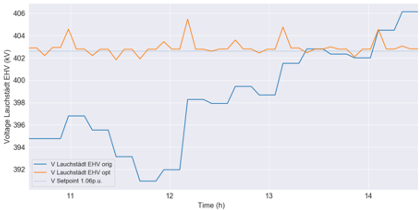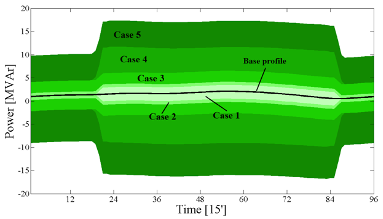EU-SysFlex blog: Exploitation of power flexibilities from distribution networks: the importance of simulations. Outcomes from Task 6.3
10.09.2020NewsSimulations take on a great importance in the investigation of demonstrator networks’ handling and operations in scenarios which differ from the Business-as-Usual. Furthermore, simulations serve as a testing, de-risking and validation environment for the other tools, in preparation of their deployment in the physical demonstrations’ set-ups.
Therefore, the simulations presented and described in Deliverable D6.3 take on two main purposes: investigating specific operating conditions, in line with the project assumptions and scopes, which cannot be replicated and tested in the physical set-ups of the demonstrators, and testing the operations and the reliability of the software parts (tools and systems) of the demonstrator set-ups.
Suitable scenarios, which model novel flexibility management within the actual demonstrator networks, are simulated for different objectives: assessing the flexibility potential of these networks, its impact on the distribution network constraints and, in general, the performances of the demonstrations set-ups in presence of the specific operating conditions, which may arise from the exploitation of the decentralised resources for flexibility provision to the TSO. Such scenarios may be beyond the technical capability of the networks and systems and also beyond the regulations presently in effect: simulations show possible ways how to deal with these scenarios and so, in addition to their contribution to the demonstrators’ activities, the achieved results support further analysis on the evolution of the electric power networks. Selected scenarios are strongly influenced by the different features and background of each demonstrator and so, the adopted simulation approaches reflect such differences.
Simulation tests carried out for German demonstrator are aimed at analysing the impact of different reactive power control modes and asset behaviours in HV distribution network on the status of EHV transmission network; in parallel, the simulation environment was exploited to evaluate preliminary optimisation results. The test results show that the adopted simulation approach allows to successfully identify which reactive power control modes are better suited for achieving a more effective local and global voltage stabilisation; they demonstrate that the reactive power flexibility optimization from the DSO offers the best results in this sense. The system and methods developed within the German demonstration show promising application in exploiting local reactive power flexibility as a systematic way to sustain the local voltage stability; the inclusion of DERs from the MV distribution network can further support this concept, increasing the available flexibility. No major violations are observed for any of the control modes tested, making them potentially applicable without the risk of negatively affecting the optimal operations of distribution network. The achieved results confirm the soundness of the demonstrator set-up and the reliability of the developed algorithms.

Simulation tests carried out for Italian demonstrator are aimed at determining the actual range of total active and reactive power capability of the demonstrator network (MV radial distribution network), as well as at investigating the scalability of flexibility potential for different network scenarios and different types of resources and the corresponding impact on network constraints. Test results show that the adopted simulation approach allows to calculate the potential range of active and reactive power flexibility for different resources set-ups (case scenarios), showing that the resulting capabilities can virtually allow very high degrees of freedom for power exchange at primary substation. Through case scenarios analysis, it is possible to identify which resources set-ups can actually provide a suitable range of flexibility and what the corresponding limitations are: in particular, the predominance of PV plants results in wide capability areas, but their full exploitation in the hot season can cause voltage violations; on the other side, the exploitation of dedicated assets (i.e. STATCOMs in this case) can extend the power modulation in other time periods and can potentially overcome the issues related to local voltage violations. Simulations also show that voltage violations may occur only for the full potential reactive flexibility exploitation, but they can easily be avoided in return for a small reduction of flexibility area. Excluding such extreme operating conditions, no major voltage and current constraints violations are observed, so reactive flexibility provision in the Italian demonstrator can be done without creating harmful operating conditions for the distribution network. These results confirm that the concept of aggregation of flexible resources at distribution level can be applied in the Italian national scenario and that the participation of all the distributed flexible resources, already connected, may allow to have a suitable flexibility range for meeting the needs of both TSOs and DSOs.

Outcomes of the analysis presented in Deliverable 6.3 show that both simulation approaches contribute to the pursuing of an optimal state for the distribution network, considering potential TSOs requests, helping effectively identify better control strategies for distributed resources, maximizing flexibility exploitation in order to potentially address needs of the transmission network, without negatively affecting the operating conditions for the distribution networks.
The two approaches are analysed from a different point of view in order to identify how they can be exploited jointly, complementing each other, and so translating the concept of simulations into a holistic perspective.
The physical set-ups can be linked together by the means of primary substations, as it actually happens between HV and MV networks; bi-directional data flows could be established at primary substation interconnections, realising a bijective link between the inputs and outputs of the simulation tools applied to each set-ups. In brief, the results coming from simulation tests of one demonstrator could be exploited in the simulation test of the other one and vice versa. Alternatively, both simulation approaches could be applied jointly in a single analysis, returning valuable results for both the demonstrators.
In conclusion, if the results from simulation tests carried out within each demonstrator, regardless of the operational scenarios considered, could be complementary with the results from simulation tools/approaches applied to the other demonstrators, it is possible to realize a global simulation analysis of the virtual set-up, in line with a holistic view of the European electricity system.
Written by: Daniele Clerici from RSE S.p.A.